
The Acadians are the descendants of the French who settled in Acadia during the 17th and 18th centuries, some of whom are also descended from the Indigenous peoples of the region.

Acadia was a colony of New France in northeastern North America which included parts of eastern Quebec, the Maritime provinces, and Maine to the Kennebec River. During much of the 17th and early 18th centuries, Norridgewock on the Kennebec River and Castine at the end of the Penobscot River were the southernmost settlements of Acadia. The French government specified land bordering the Atlantic coast, roughly between the 40th and 46th parallels. It was eventually divided into British colonies. The population of Acadia included the various indigenous First Nations that comprised the Wabanaki Confederacy, the Acadian people and some small Scottish settlements.

Hants County is a county in the Canadian province of Nova Scotia.

The Expulsion of the Acadians, also known as the Great Upheaval, the Great Expulsion, and the Great Deportation, was the forced removal by the British of the Acadian people from the present-day Canadian Maritime provinces of Nova Scotia, New Brunswick, Prince Edward Island and northern Maine — parts of an area historically known as Acadia. The Expulsion (1755–1764) occurred during the French and Indian War and was part of the British military campaign against New France. The British first deported Acadians to the Thirteen Colonies, and after 1758, transported additional Acadians to Britain and France. In all, of the 14,100 Acadians in the region, approximately 11,500 Acadians were deported. A census of 1764 indicates that 2,600 Acadians remained in the colony having eluded capture.

Windsor is a community located in Hants County, Nova Scotia, Canada. It is a service centre for the western part of the county and is situated on Highway 101.

Falmouth is a village located along the Avon River in Hants County between Mount Denson and Windsor in the Canadian province of Nova Scotia.
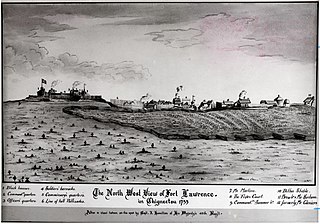
Fort Lawrence was a British fort built during Father Le Loutre's War and located on the Isthmus of Chignecto.

Hantsport is a Canadian community located in Hants County, Nova Scotia. It is administratively part of the Municipality of the District of West Hants.

Fort Edward is a National Historic Site of Canada in Windsor, Nova Scotia, and was built during Father Le Loutre's War (1749-1755). The British built the fort to help prevent the Acadian Exodus from the region. The Fort is most famous for the role it played both in the Expulsion of the Acadians (1755) and in protecting Halifax, Nova Scotia from a land assault in the American Revolution. While much of Fort Edward has been destroyed, including the officers quarters and barracks, the blockhouse that remains is the oldest extant in North America. A cairn was later added to the site.

The Acadians are the descendants of the French settlers, and sometimes the Indigenous peoples, of parts of Acadia in the northeastern region of North America comprising what is now the Canadian Maritime Provinces of New Brunswick, Nova Scotia and Prince Edward Island, the Gaspé peninsula in eastern Québec, and the Kennebec River in southern Maine.
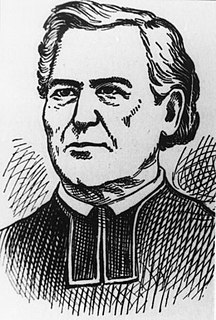
Abbé Jean-Louis Le Loutre was a Catholic priest and missionary for the Paris Foreign Missions Society. Le Loutre became the leader of the French forces and the Acadian and Mi'kmaq militias during King George's War and Father Le Loutre's War in the eighteenth-century struggle for power between the French, Acadians, and Miꞌkmaq against the British over Acadia.

The St. Croix River is a river in Nova Scotia entirely contained in Hants and Halifax Counties. Its headwaters are Panuke Lake. The river has been exploited for water power. There were water mills in the nineteenth century and in the 1930s three hydroelectric dams were built; they still operate.

St. Croix is a community in the Canadian province of Nova Scotia, located in Hants County, Nova Scotia.

Mount Denson is a small community in the Canadian province of Nova Scotia, located in The Municipality of the District of West Hants in Hants County. The community is named after Mount Denson; the mid-eighteenth-century estate of Henry Denny Denson.
Noël Doiron was a leader of the Acadians, renowned for his leadership during the Deportation of the Acadians. Doiron was deported on a vessel named the Duke William (1758). The Duke William sank, killing many passengers, in one of the worst marine disasters in Canadian history. The captain of the Duke William, William Nichols, described Noel Doiron as the "father" to all the Acadians on Ile St. Jean and the "head prisoner" on board the ship.
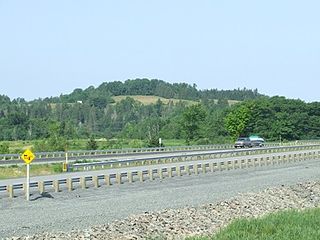
The Battle at St. Croix was fought during Father Le Loutre's War between Gorham's Rangers and Mi'kmaq at Battle Hill in the community of St. Croix, Nova Scotia. The battle lasted from March 20–23, 1750.
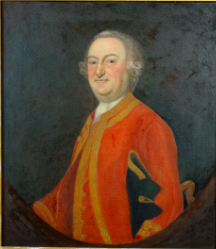
The Bay of Fundy Campaign occurred during the French and Indian War when the British ordered the Expulsion of the Acadians from Acadia after the Battle of Fort Beauséjour (1755). The Campaign started at Chignecto and then quickly moved to Grand-Pré, Rivière-aux-Canards, Pisiguit, Cobequid, and finally Annapolis Royal. Approximately 7,000 Acadians were deported to the New England colonies.
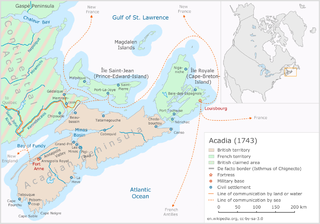
Father Le Loutre's War (1749–1755), also known as the Indian War, the Micmac War and the Anglo-Micmac War, took place between King George's War and the French and Indian War in Acadia and Nova Scotia. On one side of the conflict, the British and New England colonists were led by British Officer Charles Lawrence and New England Ranger John Gorham. On the other side, Father Jean-Louis Le Loutre led the Mi'kmaq and the Acadia militia in guerrilla warfare against settlers and British forces.

Fort Sackville was a British fort in present-day Bedford, Nova Scotia. It was built during Father Le Loutre's War by British adjacent to present-day Scott Manor House, on a hill overlooking the Sackville River to help prevent French, Acadian and Mi'kmaq attacks on Halifax. The fort consisted of a blockhouse, a guard house, a barracks that housed 50 soldiers, and outbuildings, all encompassed by a palisade. Not far from the fort was a rifle range. The fort was named after George Germain, 1st Viscount Sackville.
The old Acadian villages in Nova Scotia have been lost due to deportation in 1755. During this period many villages were burned down by Col. John Winslow.













